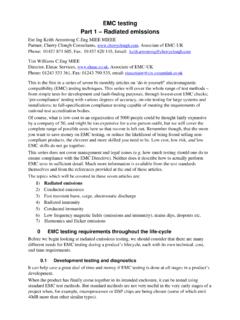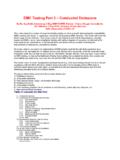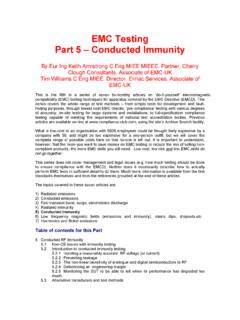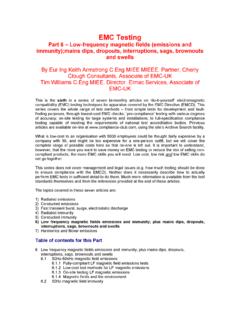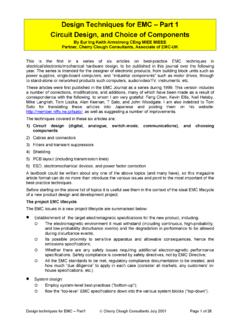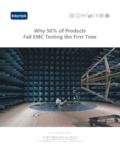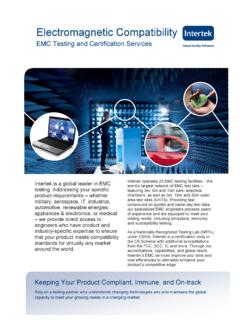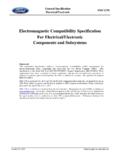Transcription of EMC Testing Part 3 - compliance-club.com
1 EMC Testing part 3 Fast Transient Burst, Surge, Electrostatic Discharge By Eur Ing Keith Armstrong MIEE MIEEE, Partner, Cherry Clough Consultants, Tim Williams MIEE, Director, Elmac Services Both Associates of EMC-UK This is the third in a series of seven bi-monthly articles on do-it-yourself electromagnetic compatibility (EMC) Testing techniques for apparatus covered by the European EMC directive. This series will cover the whole range of test methods from simple tests for development and fault-finding purposes, through lowest-cost EMC checks; pre-compliance Testing with various degrees of accuracy, on-site Testing for large systems and installations; to full-specification compliance Testing capable of meeting the requirements of national test accreditation bodies. Of course, what is low-cost to an organisation of 5000 people could be thought fairly expensive by a company of 50, and might be too expensive for a one-person outfit, but we will cover the complete range of possible costs here so that no-one is left out.
2 Remember though, that the more you want to save money on EMC Testing , or reduce the likelihood of being found selling non-compliant products, the cleverer and more skilled you need to be. Low cost, low risk and low EMC skills do not go together. This series does not cover management and legal issues ( how much Testing should one do to ensure compliance with the EMC Directive). Neither does it describe how to actually perform EMC tests in sufficient detail. Much more information is available from the test standards themselves and from the references provided at the end of these articles. The topics which will be covered in these seven articles are: 1) Radiated emissions 2) Conducted emissions 3) Fast transient burst, surge, electrostatic discharge 4) Radiated immunity 5) Conducted immunity 6) Low frequency magnetic fields (emissions and immunity), mains dips and dropouts, etc. 7) Harmonics and flicker emissionsTable of contents for this part 3 Fast transient burst, surge, electrostatic discharge Standardised immunity Testing versus real-life reliability Hiring test gear may be the best way to Do-It-Yourself Combination test instruments Buying second-hand test gear Fast Transient Burst (FTB) Details of the standard test Fully compliant Testing On-site Testing Alternative FTB generators Surge Fully compliant Testing On-site Testing Alternative surge test generators Electrostatic discharge (ESD)
3 Fully compliant Testing On-site ESD Testing Alternative ESD test generators Locating faults during immunity Testing Test instruments Localised immunity Testing 3 Fast transient burst, surge, electrostatic discharge part 0 of this series [1] described the various types of EMC test that might be carried out, including: Development Testing and diagnostics (to save time and money) Pre-compliance Testing (to save time and money) Full compliance Testing QA Testing (to ensure continuing compliance in volume manufacture) Testing of changes and variants (to ensure continuing compliance). And part 0 also described how to go about getting the best value when using a third-party test laboratory [1]. This part of the series focuses on Testing conducted emissions to the EN standards for typical domestic / commercial / industrial environments.
4 Other kinds of immunity tests may be required by the EMC standards for automotive, aerospace, rail, marine and military environments. In particular, the conducted transients and surges in an automotive environment (internal combustion engine with spark ignition, driving an alternator, which charges a battery) can be very different indeed from those typical of a building connected to a 230/415V mains power supply, as shown by ISO 7637 [2], for example. These industries have over the years developed their own test standards based on their own particular kinds of disturbances, for reliability reasons. IMPORTANT SAFETY NOTE: Some of these tests involve electrically hazardous conductors ( mains), and/or hazardous voltages or energies. These tests can be dangerous, and all appropriate safety precautions must be taken. If you aren t sure what safety precautions are needed, ask an expert. The basic EN test methods described here are identical to the basic IEC test methods ( EN 61000-4-4 is identical to IEC 61000-4-4), so this article may also be of use where non-EU EMC specifications apply.
5 Standardised immunity Testing versus real-life reliability These three immunity tests use carefully-defined generators with carefully-defined waveforms and test set-ups to try to achieve a repeatable test. There is plenty of experience to show that the tests are not as repeatable as one might wish, and the standards are continually being developed to try to improve this (read [3] for more on this issue). But it is important to realise that these standards do not necessarily simulate the real-world electromagnetic disturbances very well. The waveforms specified by their tests are more likely to reflect what it is possible to generate cost-effectively and repeatably in a laboratory instrument, than be an accurate simulation of the disturbance waveforms present in real applications. For example, the fast transient burst test aims to simulate the disturbances created by a showering arc at the contacts of an ordinary AC mains switch or relay contacts as it opens.
6 The inductance of the mains cable (plus any in the load) causes a flyback voltage at the instant the current is interrupted, and the flyback voltage rises until it is sufficient to break down the air gap at the contacts and make an arc. When the arc stops the flyback occurs again, this time with the contacts slightly further apart. So during the opening of a switch or relay contact the transients generated can look something like Figure 3A, starting off with a low amplitude and a high frequency (could be MHz) and with rising amplitude and falling frequency as the contact gap widens. Compare this with the waveform of the standard EN 61000-4-2 test in Figure 3C, which uses a constant amplitude and frequency (5kHz). It is true to say that a product designed to meet these standards will generally be more reliable (all things being equal) than one which has been designed with little or no thought to surviving these disturbances and no Testing .
7 But meeting these standards does not guarantee freedom from errors or failure in the field due to the disturbances represented by these three standards. For example, surge Testing according to EN 61000-4-5 is called up by the generic standards and most of the other immunity standards harmonised under the EMC directive, usually at the level of 1kV for line-to-line surges and 2kV for line-to-ground. However, it is well known (and recognised by some lightning protection standards) that in Europe and the USA at least the mains power in typical urban buildings will suffer from line-to-ground surges of 6kV at least once per year. This is caused by normal thunderstorm activity in the local area, not direct strikes, and applies to buildings which do not have lightning protection systems designed to protect electronics. Rural buildings whose mains supply is carried by overhead conductors, can reckon on experiencing many tens or hundreds of 6kV surges every year, depending on the length of their overhead line.
8 The figure of 6kV arises because the typical domestic-style mains sockets flash-over at their rear connections at around this voltage and so act like spark-gap suppressers. In industrial premises mains distribution using three-phase supplies fitted only with the larger three-phase mains sockets might suffer from line-to-ground surges of well over 6kV due to the increased flash-over voltage of these sockets. It is ironic that in buildings whose mains wiring has poor quality insulation, the maximum surge voltages can be much less due to the accidental spark-gaps (which are also fire hazards) created by the poor quality wiring. One of the authors has experience of a mains power supply module widely used in Europe that suffered from an excessive failure rate. This turned out to be due to the fact that the creepage and clearance distances between the track to the gate of a switching power FET and the earthed chassis were inadequate at over 5kV (when Testing with the EN 61000-4-5 waveshape).
9 These modules would clearly pass all the immunity standards harmonised under the EMC directive, but were almost certain to fail at least once per year in most indoor urban environments in Europe and the USA. Another example relates to electrostatic discharge (ESD). The test standard called up by EMC directive harmonised immunity standards is EN 61000-4-2, but this only covers personnel discharge ( from people s fingers, keys, etc.). Leaving aside questions about the accuracy of its simulation of actual personnel ESD events into a variety of real-life load impedances, it does not even try to address other types of ESD events which may be very important in real-life applications, such as furniture ESD and machine ESD. Machine ESD can be very severe indeed in some industries, especially where webs of insulating material (paper, plastic film, etc.) or insulating gases, dusts ( flour) or liquids are processed. Even a motor running in plastic bearings can generate severe ESD events between its rotor and its stator.
10 There are almost as many possible ESD waveshapes as there are applications with machine-ESD problems. So, where it is desired to create reliable products, the EMC immunity work done should go beyond the standard EMC directive immunity tests: Consider whether the test levels on the standard EMC directive immunity tests should be increased to address the real-life situation for disturbances with a similar waveshape. Consider whether the real-life disturbances in the intended environment are sufficiently different from the EMC directive s standard tests to make a different type of test necessary. Where a standard test method does not exist to cover your real-life environment, with a little ingenuity it is often possible to design your own fast transient burst, surge, or electrostatic discharge tests that simulate the expected environmental threats. Sometimes this requires little more than replicating whatever it is that is causing the threat ( a 10kVA transformer and its on/off contactor) or if this would require too much work taking prototype products to where the threat exists.
